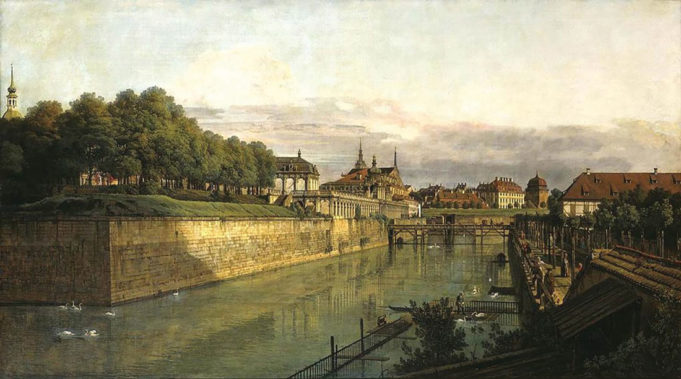It’s not often that a single art exhibition reveals so much about a relatively obscure place during a consequential time in world history and all through the lens of a great artist who is likely unknown to the general museumgoer.
But that is precisely the laudable achievement of the Kimbell Art Museum’s latest exhibition. In the highly accessible Lure of Dresden –– Bellotto at the Court of Saxony, Bernardo Bellotto, often considered one of history’s great “view” painters, is presented as the artistic Boswell to his main muse: mid-18th century Dresden in all of its urban splendor and colorful inhabitants.
In 28 works, The Lure of Dresden hones in on the city’s magisterial and human-scale beauty through Bellotto’s fastidious brushstrokes. The show’s works, culled from Bellotto’s two Dresden periods, when he served as Saxony’s official court painter, reveal his bravado approach to composition and perspective on the sweeping vistas of Dresden and his uncanny ability to detail a hive of daily life, involving all manner of eclectic characters.
Most of Bellotto’s grand-scale works (many 8 feet wide) reflect his output during his first Dresden period, from 1747 to 1758. Then, while court painter to Frederick August II, Bellotto immortalized the monarch’s massive building campaign designed to glorify Dresden’s artistic and architectural profile.
Most of these works come from the Gemaldegalerie from the Dresden State Art Collections. Two works from Bellotto’s less prodigious “second Dresden period” (1761-1766) are on loan by Canada’s Agnes Etherington Art Center (Queen’s University) and the El Paso Museum of Art.
These works demonstrate Bellotto’s most significant painterly virtues: manipulating light and composition to draw the viewer’s attention to certain aspects of the cityscape and its inhabitants. Bellotto’s works entice the eye to wander over the entire canvas, taking the viewer in a cinematic sweep from the long view of his urban-scapes to the close-up of precise, human detail.
The exhibition’s opening gallery is devoted to the 18th-century historical backstory surrounding the key ruler of Saxony at the time of Bellotto’s arrival to court. Easily the most stunning work here is a 3-foot-tall Meissen porcelain titled “Grand Vase of Snowball Blossoms with Relief Portrait of King August III (1741-42),” a superlative example of Baroque style, replete with hand-modeled flourishes, wrought from hard-paste “white gold” porcelain.
Bellotto’s elevation of 18th-century Dresden to near mythic heights is seen clearly in “Entrance to a Palace,” which transforms any typical grand city of that era into a monumental, architectural classic, complete with an ascending staircase, columned porticos, and arcades fronted by an opulent Bernini-style fountain.
Bellotto’s grasp of light and shadow, coupled with an attention to the most telling of human detail, is better understood upon learning that his principal mentor, and uncle, was Antonio Canaletto, a revered master of those same techniques. In examining the three sublime Canaletto works that presage the show’s Bellotto pieces, pay close attention to Canaletto’s “The Campo San Giacometto di Rialto in Venice” and its hypnotic alternating of dusky shadow to penetrating sunlight, or the benevolent sunlight of “The Canal Grande in Venice.” These two works demonstrate Canaletto’s enormous “Italian viewpoint” influence on Bellotto’s Dresden oeuvre.
Bellotto’s trademark combination of the grand-scale paired with the minute is vividly apparent in “Dresden from the Right Bank of the Elbe above the Augustus Bridge.” The overall perspective is massive in scale, taking in the mirrored surface of the Elbe River, bordered by a spired palace, and the “Frauenkirche,” a domed Protestant church crowding its left bank.
Then Bellotto immerses the viewer in a gaggle of citizens in the work’s foreground, paying particular attention to a court doctor, an opera singer, a Turkish retainer, and a guardsman –– all chatting convivially, with many costumed in shades of red and pale sapphire.
“The Zwinger Moat in Dresden” showcases Bellotto’s incomparable ability to conjure simultaneously the large and small scale within a single work. From afar, the work portrays the placid waterway of Dresden, along with the horizon-etching skyline of the city’s various court buildings near the royal palace. But, upon closer inspection, the visual rewards include the exquisite detail of the moat’s wall, a lush urban park, and waterfowl bobbing on the water’s glassy surface.
During this creatively fertile time, Bellotto traveled to Pirna, roughly 12 miles southeast of Dresden. From the verdant “Pirna from the Posta Hills” to the milestone-marked, crossroads atmosphere of “The Breite Gasse in Pirna,” Bellotto conveys both the bucolic quality of Pirna’s rolling hills and a sliver of city street-theater where yapping dogs scamper as a blacksmith sets up his shop, all under a late-day Cognac sun.
Finally, Bellotto’s irrefutable Baroque credentials foreshadow the future Impressionists’ dazzling approach to water’s ineffable quality. In “Pirna Viewed from Copitz,” a calm Elbe River is a marvel of mirrored light and softly rippling surface, a proverbial reflector of a captured moment of daily life where a boat plies the water while a couple fishes at its edge.
Clearly, Bellotto is reveling in this view of Pirna, as in the entirety of Dresden, and by every revealing detail he crafts from his palette, he exhorts us to share in his unabashed adoration of his urban subject.
The Lure of Dresden — Bellotto at the Court of Saxony
Thru April 28 at the Kimbell Art Museum, 3333 Camp Bowie Blvd, FW. $14-18. 817-332-8451.












